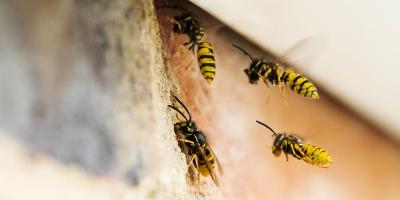How to Protect Your Brain from Earwigs

Everyone knows there are two creatures that want to eat your brains -- zombies, of course, and earwigs. What many people may not realize, however, is that both ideas are works of fiction. That’s right -- despite the popular myth that earwigs will crawl into your ears, lay eggs in your ear canals and slowly eat your brains, it’s just simply not true.
But that doesn’t mean you should ignore the threat posed by earwigs (or zombies for that matter, if they ever show up at your doorstep).
Earwigs Don’t Bite -- They Pinch
Although earwigs do get their name from the old myth that they get to your brain by way of your ear canals, the truth is that earwigs hardly ever even bite humans. Far more likely is that an earwig might pinch you with the pincers located on the back of its abdomen.
Although it’s uncommon, an earwig pinch can, and occasionally does, break the skin. Even then, however, the injury is no worse than a typical scratch and should be treated as such by cleaning it with soap and water, then topping it with antibacterial cream and a bandage for extra protection.
Earwigs Love a Good Mess
Earwigs are small to medium-sized bugs, ranging from about a quarter-inch to a full inch in length. They vary in color from dark brown to an almost reddish hue, but the thing that sets them apart the most is that pair of menacing-looking pincers on their hindquarters.
Not all earwigs fly, and the ones that do only fly in short bursts. They’re attracted to lawn debris, mulch and tree holes, and get into your house through exterior gaps and cracks. That means that the key to keeping them out is to maintain a tidy yard and seal up any potential entryways into your home -- sound advice that’ll keep any number of critters out.
Telltale Signs You’ve Got an Earwig Problem
Aside from simply observing earwigs in your home (they’re nocturnal, so you’re more likely to catch them at night), you may have a hidden earwig problem if you catch a whiff of the foul stench they give off when crushed. If you’ve also got dead plant material piled up on your yard or windowsills, that could be what attracted them.
Earwigs prefer cold and moist locations, which is why they’re often found in basements and crawl spaces… especially in older homes with leaky plumbing.
Their Power is Not in Numbers
Unlike many other pests, you typically won’t see large numbers of earwigs together -- they’re usually found in small groups where there’s an abundance of food and protection. But that’s not to say that they don’t do any damage.
Earwigs in your home are considered an “accidental invader” -- there’s really nothing there for them that they can’t get outside. However, although they are relatively harmless indoors (since brains aren’t actually on their menu), earwigs can wreak havoc on your outdoor garden. Earwigs will chew on flowers and vegetable plants, creating ragged holes on the leaves and petals of your vegetation.
Evict Earwigs by Cleaning Inside and Out
The best way to deal with an earwig infestation is to clean up inside and outside your home. Get rid of leaf piles, rotten wood, built-up mulch and other extra vegetation -- living and dead. Clean out gutters and downspouts and keep them pointed away from the house to avoid water pooling.
Check the foundation for cracks or holes, make sure all your windows close and eliminate any gaps or holes in your window screens.
And finally, if your earwig problem persists or, heaven forbid, gets worse, it might be time to call in a pest control professional to get rid of the problem for good.
We may not know much about brains, but we sure know pests and how to keep them out of your house. Click here to find out more about how we can help keep your home pest-free.



